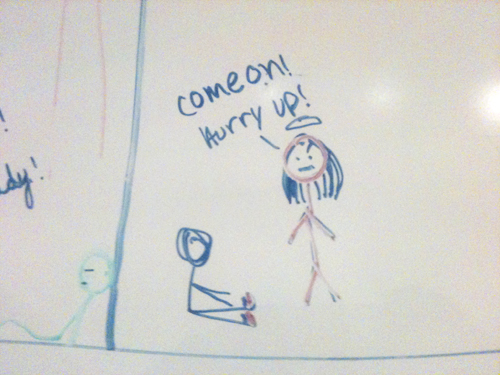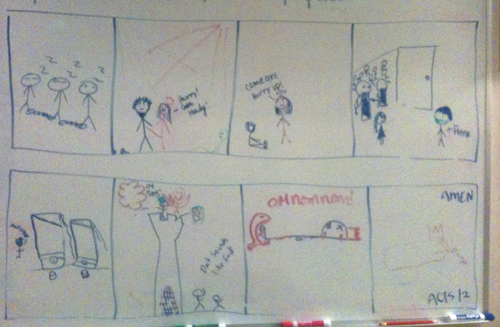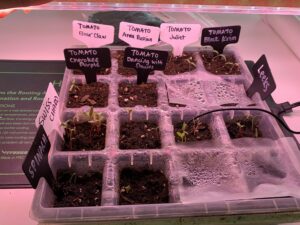We started out the book of Acts with some excitement — or something like it. Some terrible weather rolled in to the area, resulting in changes to the student’s exam and class schedules. We had to cut out several days of class, but it didn’t hurt our reading schedule too much.
January is always like this for us. I don’t know why we can’t start school three weeks earlier so the kids can have finals before Christmas and avoid the nightmare scheduling that comes in January. There are two regular holidays, plus the end of winter break, plus a week of half days for exams, and there are invariably snow days…. it’s ridiculous.
Anyway. Back to the Acts.
We are reading about 8-10 chapters a week from now on to complete the New Testament. So far the kids have done exceptionally well with their reading. I hope that the good habits they’ve gotten into will sustain them through the epistles. Those are really difficult reading, at least for me.
NOTE: I spent an hour recounting in great detail the past several lessons, however, my internet died and the post was lost. I am rewriting just the activities and things I think are the most helpful for other teachers from the lessons, especially the activities we did during class.
Acts 1-2
Because this was our first day back after an extended winter-weather related break, I started this section off with a Pop Quiz. I gave students a two minutes to review chapter 1, had them number their paper 1-10, and asked the following questions:
- Who wrote the book of Acts of the Apostles? (BD, Acts of the Apostles)
- How long was Jesus on the Earth with the NT apostles after his resurrection? (v3)
- Jesus told the apostles to go to Jerusalem and wait for what? (v 4)
- Jesus told the disciples to be witnesses in three geographic areas. The first was Jerusalem; the second was Judea and Samaria. What was the third? (v8)
- Jesus was taken up in a _____. (v9)
- The angels said Jesus would return to the Earth how? (v11)
- What was the name of the mountain Jesus ascended from? (v12)
- The apostles needed a replacement for Judas. Name on criterion they wanted in a new apostle. (vv 21-22)
- How was the new apostle chosen? (v 24, 26) (I had noted Proverbs 16:33 as a cross reference to show that the casting of lots was not guesswork.)
- What was the name of the new apostle?
After some lesson summary, we read Mormon 9:20 and D&C 63:8–12. We looked in chapter 2 for signs that follow them that believe, or fruits of the spirit and listed them.
Acts 3 – Day of Pentecost
On the board I wrote
Which came first, the chicken or the egg? The sign or the faith?
I used this to start a discussion of what it takes to be healed and why we sometimes ask for one thing and get another — the man asked for money and received strength instead. How does what we know about God fit with why we sometimes don’t get what we ask for? cf Moses 1:39
Our activity was to read vv12-26. Students chose what they felt was the most important things in the section and shared it with the class.
Acts 4-5
We watched the Bible videos
- Peter and John Heal a Man Crippled Since Birth (3:22)
Acts 3:1-8 - Peter Preaches and Is Arrested (2:51)
Acts 3:12-26, 4:1-3
The following week a new video came out called Peter and John Are Judged. Wish it had come out sooner.
After our lesson summary we did what did you underline on the following verses:
Acts 6-7
The main activity on this day was to memorize the scripture mastery in Acts 7. I wrote the scripture on the board and after our lesson, I erased a few words at a time to help students memorize it. This was a particularly good Scripture Mastery lesson, because after our discussion on why this was an important scripture, THEN we memorized it. My students are much more motivated to memorize when they understand how a passage will help them on their missions.
Acts 8-9
On this day, we reviewed the storiest from Acts 8 and 9 and then acted them out. Under each chair I put a costume item like a wig or hat or dres and a post it note with one of the following assignments:
- Ethiopian Acts 8:26–39
- Philip Acts 8:26–39
- High priest Acts 9:1–2
- Saul Acts 9:1–30
- Follower of Saul Acts 9:3–8
- Lord Acts 9:4–6
- Ananias Acts 9:10–18
- Disciple with basket Acts 9:24–25
- Barnabus Acts 9:26–30
- Apostle Acts 9:26–30
- Peter Acts 9:36–41
- Tabitha Acts 9:36–41
- Widow Acts 9:39
- disciple Acts 9:37–39
This was a lot of fun. For whatever reason, we had a ton of students absent on this day, so I ended up playing the parts of the widow and disciples in the raising of Tabitha. It was the first time I ever acted with the kids. Pretty fun.
Acts 10-11
I was not welll prepared for today’s lesson, and so I’m not going to bother reporting on it. It wasn’t a complete disaster, but there’s nothing really to report on either….
Acts 12 – Peter in prison
This lesson turned out better than yesterday’s. I spent a little more time on my transitions during lesson planning this time and it went a lot more smoothly. There isn’t a whole lot of doctrinal stuff to cover here, but the chapter is pretty funny. VERY funny, in fact.
I decided to hit on the “no respecter of persons” thing again today, emphasizing that we must not be respecters of persons based on their clothing or race. I also taught that we must not judge ourselves by those criteria either. It doesn’t matter what our size or color is — God loves us.
I tied all this up into a neat bow by teaching that King Herod was a respecter of persons. He made decisions based on what would make the people happy. He loved fame more than righteousness. He imprisoned Peter because it would make the Jews happy, and he was killed because he didn’t correct the people when they thought he sounded like a god during his speech.
For our activity, I drew some boxes like a comic strip on the board. It’s basically a combination of Group Drawing, Gospel Cartoonist, and Team Adds Details teaching techniques. I had students come up one at a time and draw a frame for the comic. The others followed along in their scriptures making suggestions on what the person should add to the picture. This was a lot of fun and kept everyone paying attention. The other goal of this activity is that every person really gets to know the details of the story because they are self-correcting. Or maybe it’s group-correcting. Either way, it worked well for getting kids into the text and putting themselves into the story.
My students liked drawing the worms eating the king. The final frame was empty, so one kid came up and drew a burping worm. LOL.
Here are some of the pictures of the activity:
If the story had had a little more depth, we could have had a really good gospel discussion. In fact, I liked it so well, if I am teaching this next year, we will probably do Tree of Life vision this way. We could add in layers of understanding as we go along. First, we could draw the story. Then we could label it. Then we could add in the interpretation of the dream.
Anyway, I’m still here, still teaching away. I hope that students will continue to learn.



